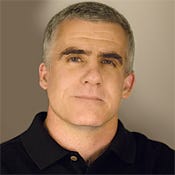Tech Hotshot, Want To Work At A Railroad?
Union Pacific has to put a lot of energy into internships and recruiting to lure its IT talent.

When Union Pacific IT recruiters attend job fairs on college campuses nationwide, they typically look on enviously as long lines queue at the booths of Google, Microsoft, Oracle, and other tony tech employers. Union Pacific CIO Lynden Tennison realizes he has a big challenge on his hands to convince students that a 150-year-old railroad freight hauler based in Omaha, Neb., is an attractive alternative. But he has a plan.
Tennison figures that if he can get students to spend a few months interning at UP headquarters, he can hook them. The company's IT organization recruits at the likes of Purdue, Michigan State, Georgia Tech, Texas, even MIT, as well as locally at Nebraska and Iowa State. Only 10% of the college students it makes job offers to accept, he says, but that rate jumps to 70% to 75% among students who have interned at headquarters.
The IT organization's 40 summer interns and 70 year-round interns are paid between $15 and $24 an hour; those from outside the Omaha area get housing, a meal plan, transportation, and relocation assistance. It also has seven high school interns doing system and training documentation, performing data validation, and creating scripts to migrate data during system upgrades. "We try to push on all sides as much as we can to grow the pool," Tennison says.
What does UP have to offer more seasoned IT pros? Tennison runs through a few attributes:
>> UP is doing leading-edge work--in real-time and predictive analytics, hardware engineering, sensor-based mote technology, train communications, and other areas. It develops and builds much of its own IT (see Why Union Pacific Builds Its Own Tech).
To promote a culture of IT innovation, Tennison three years ago initiated a website where anyone in the IT organization can post and comment on an IT-related idea anonymously. If 80% of voters give the idea a thumbs up, the person who proposed it gets $3,000 and up to 80 hours of work time to whip it into a prototype. If the idea is then deemed worthy of additional investment or deeper analysis, a formal plan is drawn up. Tennison estimates that UP has realized $10 million in benefits from the program, mostly from one idea on how to minimize false positives generated by rail wayside tracking systems, which were needlessly stopping trains.
>> Omaha, where most of the company's IT employees work, isn't the most hopping place for a college grad, but it has a lot to offer. It ranked eighth on the 2011 Best Cities for Families list of Parenting magazine, which gave the city of 400,000 people (more than 800,000 in the metro area) props for its strong schools, "thriving job market," and "vibrant jazz presence." Along with short commutes, it has a small downtown area, supports a performing arts center, is home to three minor league sports teams, hosts the College World Series every June, and attracts a number of name entertainment acts.
>> There's employment stability at UP. Average length of service is 12 years. Attrition rates run in the 5% to 6% range, with a significant portion from retirements.
In all, the UP IT organization consists of about 2,000 people, 600 of them contractors (450 offshore, mostly in India, and 150 onshore). Of its 1,400 or so full-time employees, 400 are in telecom; 200 are in what Tennison calls "system engineering" (database management, middleware, operating systems, system programming, data warehousing); 180 to 200 are in data center operations; and most of the rest are in application development. Then there are the 50 or so computer, electrical, and mechanical engineers in the company's hardware R&D lab, who design and build everything from locomotive radios to railcar monitoring systems (see Congress' $20 Billion Tech Mandate: Make Trains Safer).
Tennison says he has never laid off an IT employee in seven years as CIO, even as he moved work offshore. His organization hired 137 people in 2011 and 70 people so far this year. It has 10 open positions, for systems architects, developers (Java, C++), and operations support (help desk, LAN, network ops).
To get access to programmers, Tennison had been bringing workers on H-1B visas to Omaha, but he found that going offshore for such work was cheaper and easier. He thinks UP's current mix of onshore/offshore IT pros is just about right, acknowledging that "you lose efficiency" with offshore contractors. "It's worked pretty effectively," he says. "I will not say it's worked without pain."
More In This Series:

InformationWeek: August 13, 2012 Issue
Download a free PDF of InformationWeek magazine
(registration required)
About the Author(s)
You May Also Like
Smart Service Management
June 4, 2024Tales of a Modern Data Breach: The Rise of Mobile Attacks
June 11, 2024The CIOs Guide to Enhancing GRC in 2024
June 20, 2024







